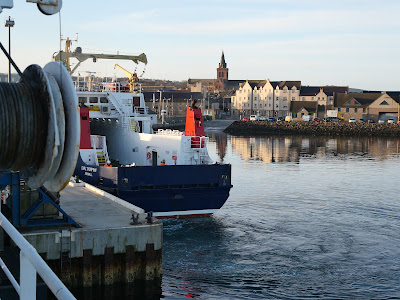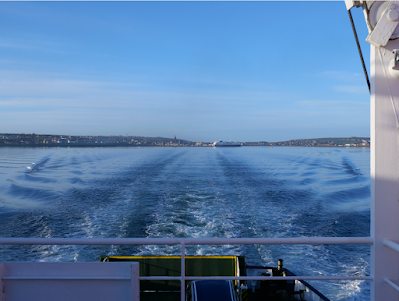 |
| April 23, 2019: Defaced cross, Lamlash Parish, Arran |
Over the course of two millennia since its founding, the Church (or to be specific, the Roman Catholic Church) has had more than its ample share of initiating: persecutions, inquisitions, excommunications, the rack...and burning at the stake. So too, eventually, the Puritans with their iconoclasm...and witches.
Considering
damages done by the iconoclasts to precious religious artwork and
sculpture, that is difficult to square by today's more enlightened standards. It's a
Taliban type of thing...iconoclasts, persecution and burkas.
The first "official" inquisition (actually a synod condemning various heretics) was initiated in 1184 by Pope Lucius III. As for inquisitions though, he did not live long enough to carry them out. He only served about two years.
 |
| April 16, 2019: Defaced Kilmichael Cross, Kilmartin |
The prize of instituting the first inquisition must go to one of his successors, Pope Innocent III, from 1209-1229. The Papacy was beset by a constant flux at the end of the 12th century. Destabilizing, in a word.
Popes rolled over as quickly as the College of Cardinals could mint them--Pope Urban III (1185-1187); Pope Gregory VIII (1187, only two months); Clement III (late 1187-1191); Celestine III (1191- early 1198); and finally Innocent III, who served some 18 years (1198-1216) and is known, for better or worse, for expanding the scope of the Crusades...including the sack of Constantinople, a Christian albeit Eastern Orthodox empire.
Begun in Languedoc in present day southern France and known as the Albigensian Crusade, or Cathar Crusade, it quickly
took on an air of mercenary adventurism. Pope Innocent III declared a crusade against the Cathars, offering lands of Cathar "heretics" to any French nobleman willing to take up
arms..."Thou shalt not covet" notwithstanding. There were plenty of takers.
The Cathar crusade expanded the French crown at the expense of neighboring Languedoc. It was a power play of sorts--eliminate competitors. Pope Innocent III claimed supremacy over Europe's Christian states, as the most powerful of all medieval Popes. As a matter of routine, he used the interdict to ban or censure, to compel his decisions, get his way. Yes, he solidified medieval canon law...but there is always a price.
 |
April 3, 2023 Queen Mary of Scots rosary; Traquair House
|
An inquisition was a systematic persecution of non-Catholic
Christian religions in Europe. Arguably, it might be said that the first true inquisition dates nearly a thousand years before Innocent III. To the late 3rd century and Arianism (256-336 AD), which was declared a heresy. (If truth be known, inquisitions probably date back to the Apostles themselves, ever bickering.)
 |
April 3, 2023 The cradle that rocked future King James VI/I; Traquair House
|
But that a "reverse persecution" would eventually supervene in the form of
Oliver Cromwell's iconoclastic Roundheads, during the English civil war
(c. 1650s), almost makes one want to belt out a rousing stanza of "
Don't Cry for Me Argentina" (Julie Covington, "Evita" concept album, 1976). Almost.
Suffice it to say that there
were persecutions aplenty. More than enough blame to go round.
 |
April 3, 2023 A hidden church; Traquair House
|
This
brings us to a period in Scotland when religious strife was tearing the
country apart--Protestant vs. Catholic. Over several decades under the Scottish Reformation, the divide would finally come out in the open. The early death of
Frances II, the Dauphine of France and husband to Mary Queen of Scots (a devout Catholic), set the stage for fierce internecine battles.
After Frances II's death, and having no place in France's succession, Mary sailed for Scotland in 1561 to take up its crown.
But having been away in France for 13 years (ever since the age of 5), Mary was not exactly
Scottish anymore. Much had changed.
The root of the conflict, of course, had its start with the English king Henry VIII, who set aside Catherine of Aragon to marry Anne Boleyn. When the Pope (Clement VII) refused to grant an annulment, Henry split from the Catholic Church and founded the
Church of England. By the time Mary arrived from France in 1561, Presbyterian lords held the reigns of power in Scotland.
 |
April 3, 2023 Priest's raiments; Traquair House
|
Despite apprehensions, Mary was actually
fairly tolerant of the newly established Protestant ascendancy in Scotland.
It was one of self-interest perhaps, for it is said she had her eye on England's
crown being the only surviving child of the Stuart King James V. She did not wish to unnecessarily antagonize Protestant opinion south of Scotland's Borders. But this put her
at odds with Scottish Catholic parties, notably with George Gordon, 4th Earl of Huntly, who
rose in rebellion in 1562 but was defeated at Corrichie, a one sided affair, on October 28, 1562...only a year after Mary had returned from France.
 |
April 3, 2023 Inside family chapel; Traquair House
|
 |
April 3, 2023 Priest Hole; Traquair House
|
Protestant Christianity, by the by, was not uniform (despite claims to the contrary) in its hostility toward the use of religious images and icons. None other than Martin Luther taught of the "importance of images as tools for instruction and aids to devotion." Luther was conservative. His words, unfortunately, fell on the deaf ears of radicals.Here perhaps a few words may clear up some confusion. Though they were contemporaries, Mary Queen of Scots is not the same as Mary I, or "Bloody Mary" the eventual Queen of England. Born February 18, 1516 as the first born child and only survivor of Henry VIII and Catherine of Aragon, Bloody Mary was legitimate by all accounts. The first undisputed Queen Regent of England from July 6, 1553 to her death November 17, 1558.
"Bloody Mary's" reign is marked with a "vigorous" determination to reverse the Reformation, to return England back to Catholicism. Once out, though, the genie is difficult to put back, after 20 years instituted by her father who first put aside Catherine of Aragon in divorce.
Her sobriquet was well-earned--she burned 300 or more at the stake. Protestants in England and Wales were summarily executed under legislation that punished any and all judged guilty of heresy against Catholicism. Legislation particularly adopted burning. Torture de rigueur, or avant-garde at any rate.
 |
April 3, 2023 Traquair House
|
Goes around, comes around. It would then be Catholicism's turn to be a hunted faith with the death of Bloody Mary. Her half-sister, Protestant Queen Elizabeth, came to the throne. Given Catholic resistance early in Elizabeth's reign, her legislation became increasingly draconian. And it would be priests who were imprisoned, tortured and killed as "pursuivants," or priest-hunters, sought those inclined to Mass.
 |
April 3, 2023 Priest Hole stair; Traquair House
|
"Priest Holes" were made in response. Priest
Holes were hiding places, typically built in houses of the wealthy in
fireplaces, attics, building alterations, under the floor boards, and especially staircases from
about 1570 until roughly 1605 with the death of Elizabeth I. Pursuivants would measure the
"footprint" of the house and compare outside versus inside measurements to see if they tallied, tapping the walls and floors for any hollow sound. All in all, Priest Holes were fairly effective, given declining numbers of priests who were executed over the next several decades under Queen Elizabeth. That, or they just lost interest in the exercise altogether.
 |
April 3, 2023 Traquair House grounds
|
With
this, we share a few photos regarding "priest holes" and Traquair House, Scotland. It is appropriate to include a line from Psalm 73 (and the 1571 medallion of the Spanish Inquisition). The olive branch symbolizes mercy; the sword punishment.
 |
April 3, 2023 Traquair House hidden stairwell
|
Again, there is more than enough blame to go around, Protestant versus Catholic; Catholic versus Orthodox (and thus Celtic). I leave to Almighty God the determination of the rightness or wrongness. We have certainly made many martyrs over time. Whether through direct affirmation or indirect apathy. All too many...on all sides. Aye then. "Arise, Lord, and judge your cause".
















